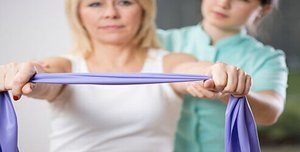Rotary cup? Rotor cuff? Most folks aren’t quite sure what it’s called—or what it does. They only
know that when it’s “bad” … life ain’t good.
The rotator cuff is actually is actually a group of muscles in your shoulder, four to be exact, that come
together to stabilize your shoulder joint as it moves. In order for the shoulder to “track” right, all
four muscles need to work synergistically.
When the rotator cuff has an imbalance—meaning that one or more of the muscles are not doing
their job due to weakness, overuse, or injury—the shoulder joint is no longer able to function as
it should. The “pulley system” is no longer working in a unified fashion, thus creating wear and
tear on the tendons of the cuff as well as the joint itself.
The three main reasons for this, as mentioned, are a weakness, overuse, and injury. More often
than not, these go hand-in-hand. The smallest muscle in the group, the supraspinatus, is located
on top of the shoulder. It is the most common culprit of injury in the rotator cuff. The reason for
this is partly its position—right under a bony prominence called the acromion process.
In a healthy shoulder, the supraspinatus muscle glides underneath the acromion process with
relative ease. But, if the muscle is overloaded due to repetitive overhead movements or just
general weakness, it becomes inflamed and swollen.
The tendon no longer glides underneath the acromion with ease, but begins to get pinched and
scraped as it travels, thereby increasing the inflammation and swelling, perpetuating the problem
further. This is called “impingement” and is the most common rotator cuff injury.
In order for injured tissues to heal, they need a few things: Avoidance of incorrect or injurious
movements, blood-borne healing agents, and gentle movement for tissue remodeling. When the
supraspinatus muscle of the rotator cuff becomes injured, it is difficult to heal, for several
reasons.
One, as mentioned, is its anatomy. Right under that bony acromion shelf.
Another reason is that, as humans, we lift our arms. A lot. Think of how many times a day
you lift your arms. Washing your hair. Putting on a shirt. Brushing your teeth. Putting dishes
away. At home. At work. Driving. If that tendon is being scraped along the acromion process all
day long, you can understand why the healing isn’t happening.
Yet another reason for the slow healing supraspinatus is its physiology. The portion of the
supraspinatus muscle that is prone to injury is tendonous. Unlike the belly of a muscle, its tendon
does not have a rich blood supply. Again, for healing to occur, blood-borne healing agents must
be present.
So what can be done? Often you hear of people who have had rotator cuff surgery to repair this
worn or torn tendon. However, to most folks, that is not the only option. I have successfully
treated many rotator cuff injuries and helped patients avoid surgery in my clinic.
We have found a combination of modalities that have proven very effective in expediting the
healing process when it comes to the rotator cuff:
Laser Therapy:
Laser therapy works by a process called photobiomodulation—a complex term used to describe a
fairly simple and very safe process. Light energy from the laser goes into the damaged tissue and
affects change on a cellular level by increasing blood flow and metabolic activity (cell turnover)
to rid the area of exudates (toxins) and speed up natural healing by stimulating adenosine
triphosphate (ATP) production and enhancing cell membrane permeability.
Ultrasound:
The use of ultrasonic sound waves in healing has been used in therapy centers and healing clinics
for decades. The sound waves penetrate down into the injured area, increasing circulation and
speeding up metabolism (cell turnover) to enhance natural healing in slow-healing areas, such as
tendons.
Exercise:
When dealing with rotator cuff healing, you have to keep moving, but there are also certain
movements you must avoid. It’s a fine line you have to navigate—making sure you are actively
using the muscle so as to promote healing and tissue remodeling, while simultaneously avoiding
movements that might cause further injury. You also need to continuously and progressively
strengthen the muscles of the rotator cuff to avoid re-injury.
Massage:
Gentle, therapeutic massage is a great way to increase blood flow and healing properties to help
heal injured muscles and tendons.
Rotator cuff injuries are debilitating. But they can be treated, and they can heal completely, given
the right environment, attention, and care.


Recent Comments